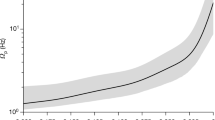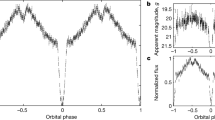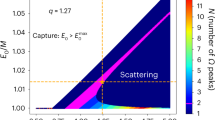Abstract
The idea that solar oscillations might have been stimulated by gravitational radiation from a nearby binary system1,2 has recently been explored by Delache and co-workers3,4. They have announced that the γ-ray source CG195+4, known as Geminga, varies in intensity with a period of 159.96min (ref. 3), and therefore has a frequency just (1 yr)−1 greater than the 160.01-min solar oscillation5–7. From this coincidence they have inferred a gravitational connection between the two oscillations. We show here that if the generally accepted ideas of gravitational radiation are correct, the 160-min solar oscillation could not have been driven to its observed amplitude by any binary system of stellar mass. Only if there were a sustained resonance between the incident radiation and a solar mode of oscillation could there be any chance of an observable response. However, gravitational radiation causes the binary system to spin up, prohibiting it from remaining in resonance with a 160-min mode for long enough to have a perceptible effect It is just possible that 5-min oscillations in the Sun could be excited to an observable amplitude by a binary system having an orbital period of ∼10 min at 1,000 AU.
This is a preview of subscription content, access via your institution
Access options
Subscribe to this journal
Receive 51 print issues and online access
$199.00 per year
only $3.90 per issue
Buy this article
- Purchase on Springer Link
- Instant access to full article PDF
Prices may be subject to local taxes which are calculated during checkout
Similar content being viewed by others
References
Isaak, G. R. Mem. Soc. astr. Italiana (eds Belvedere, G. & Paternó, L.) (in the press).
Isaak, G. R. Proc. Workshop on Solar Seismology from Space (ed. Ulrich, R. K.) (NASA, Washington DC, in the press).
Arvonny, M. Le Monde 12039, 1 (1983).
Walgate, R. Nature 305, 665 (1983).
Severny, A. B., Kotov, V. A. & Tsap, T. T. Astr. Zh. 56, 1137–1148 (1979).
Scherrer, P. H. & Wilcox, J. M. Sol. Phys. 82, 37–42 (1983).
Kotov, V. A., Severny, A. B. & Tsap, T. T. Izv. krȳm. astrofiz. Obs. 66, 3–71 (1983).
Dyson, F. J. Astrophys. J. 156, 529–540 (1969).
Landau, L. D. & Lifshitz, E. M. The Classical Theory of Fields 2nd edn (Pergamon, Oxford, 1973).
Unno, W., Osaki, Y., Ando, H. & Shibahashi, H. Nonradial Oscillations of Stars (University of Tokyo Press, 1979).
Cox, J. P. Theory of Stellar Pulsation (Princeton University Press, 1980).
Eisenfeld, J. J. math. Analysis Appl. 26, 357–375 (1969).
Dyson, J. & Schutz, B. F. Proc. R. Soc. A368, 389–410 (1979).
Peters, P. C. & Mathews, J. Phys. Rev. 131, 435–440 (1963).
Christensen-Dalsgaard, J. & Gough, D. O. Mon. Not. R. astr. Soc. 198, 141–171 (1982).
Christensen-Dalsgaard, J., Dilke, F. W. W. & Gough, D. O. Mon. Not. R. astr. Soc. 169, 429–445 (1974).
Bender, C. M. & Orszag, S. A. Advanced Mathematical Methods for Scientists and Engineers (McGraw-Hill, Auckland, 1978).
Pippard, A. B. The Physics of Vibration Vol. 1 (Cambridge University Press, 1978).
Boury, A., Gabriel, M., Noels, A., Scuflaire, R. & Ledoux, P. Astr. Astrophys. 41, 279–285 (1975).
Shibahashi, H., Osaki, Y. & Unno, W. Publs astr. Soc. Japan 27, 401–410 (1975).
Christensen-Dalgaard, J. & Gough, D. O. Mém. Soc. R. Sci. Liège 8, 309–316 (1975).
Saio, H. Astrophys. J. 240, 685–692 (1980).
Christensen-Dalgaard, J., Cooper, A. J. & Gough, D. O. Mon. Not. R. astr. Soc. 203, 165–179 (1983).
Childress, S. & Spiegel, E. A. The Solar Constant and its Variation (ed. Sofia, S.) 273–291 (NASA Conf. Publ. 2191, Washington, D. C., 1981).
Däppen, W. & Perdang, J. Mem. Soc. astr. Italiana (eds Belvedere, G. & Paterno, L.) (in the press).
Cowling, S. Mon. Not. R. astr. Soc. 204, 1237–1244 (1983).
Kotov, V. A., Koutchmy, S. & Koutchmy, O. Sol. Phys. 82, 21–35 (1983).
Kotov, V. A. et al. Sol. Phys. 82, 9–19 (1983).
Toth, P. Nature 270, 159–160 (1977).
Gough, D. O. Phys. Bull. 34, 502–507 (1983).
Kotov, V. A. Mem. Soc. astr. Italiana (eds Belvedere, G. & Paternò, L.) (in the press).
Christensen-Dalsgaard, J., Gough, D. O. & Morgan, J. G. Astr. Astrophys. 73, 121–128; 79, 260 (1979).
Author information
Authors and Affiliations
Rights and permissions
About this article
Cite this article
Fabian, A., Gough, D. Geminga and the 160-min solar oscillation. Nature 308, 160–162 (1984). https://doi.org/10.1038/308160a0
Received:
Accepted:
Issue Date:
DOI: https://doi.org/10.1038/308160a0
This article is cited by
-
The Privileged Life of a Theoretical Observer
Solar Physics (2022)
-
The 160 minutes oscillations
Solar Physics (1985)
Comments
By submitting a comment you agree to abide by our Terms and Community Guidelines. If you find something abusive or that does not comply with our terms or guidelines please flag it as inappropriate.



